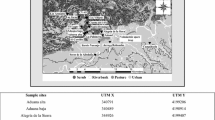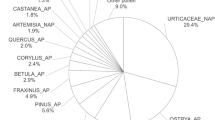Abstract
The present study sought to determine which of the common Poaceae species in the study area contribute most to the Poaceae pollen season curve, and to determine the phenological behaviour of the species studied. The different floral phenophases in thirty-three Poaceae species common in and around the city of Córdoba (SW Iberian Peninsula) were checked periodically over the period 2004–2006. Results showed that longer phenological ranges were recorded in the coolest and wettest year, and shorter ranges in the warmest and driest year. Moreover, ranges varied as a function of altitude: populations in lower-lying areas flowered earlier than those at higher altitudes. The results, taken in conjunction with the findings of preliminary research into potential pollen production, showed that probably only four of the Poaceae species studied—Dactylis glomerata, Lolium rigidum, Trisetaria panicea and Vulpia geniculata—were major contributors to the Poaceae airborne pollen curve.








Similar content being viewed by others
References
Agencia Estatal de Meteorología (2001). Guía resumida del clima en España 1971–2000. Madrid: Serie estadística, Ministerio de Medio Ambiente.
Barbieri, R., Botarelli, L., Salsi, A., & Zinoni, F. (1989). Guida alle rilevazioni agrofenologiche ed alla compilazione delle schede di rilevamento per le colture erbacee ed arboree. Bologna: E.R.S.A.
Cenci, C. A., & Ceschia, M. (2000). Forecasting of the flowering time for wild species observed at Guidonia, central Italy. International Journal of Biometeorology, 44, 88–96.
D’Amato, G., Cecchi, L., Bonini, S., Nunes, C., Annesi-Maesano, I., Behrendt, H., et al. (2007). Allergenic pollen and pollen allergy in Europe. Allergy, 62(9), 976–990.
Fornaciari, M., Romano, B., Galán, C., Mediavilla, A., & Domínguez, E. (2000). Aeropalynological and phenological study in two different Mediterranean olive areas: Córdoba (Spain) and Perugia (Italy). Plant Biosystems, 134(2), 199–204.
Galán, C., Cariñanos, P., Alcázar, P., Domínguez-Vilches, E. (2007). Spanish aerobiology network (REA): Management and Quality Manual. Servicio de Publicaciones, Universidad de Córdoba.
García-Mozo, H., Galán, C., & Vázquez, L. (2006). The reliability of geoestatistic interpolation in olive field floral phenology. Aerobiologia, 22, 97–108.
García-Mozo, H., Hidalgo, P., Galán, C., Gómez-Casero, M. T., & Domínguez, E. (2001). Catkin frost damage in Mediterranean oak (Quercus suber L.). Israel Journal of Plant Sciences, 49, 41–47.
Gómez Casero, M. T., Galán, C., & Domínguez-Vilches, E. (2007). Flowering phenology of mediterranean Quercus species in different locations (Córdoba, SW Iberian Península). Acta Botanica Malacitana, 32, 127–146.
Guardia, R., & Belmonte, J. (2004). Phenology and pollen production of Parietaria judaica L. in Catalonia (NE Spain). Grana, 43, 57–64.
Hidalgo, P. J., Galán, C., & Domínguez, E. (2003). Male phenology of three species of cupressus: Correlation with airborne pollen. Trees, 17, 336–344.
Hirst, J. M. (1952). An automatic volumetric spore trap. Annals of Applied Biology, 36, 257–265.
Jato, V., Méndez, J., Rodríguez-Rajo, J., & Seijo, M. C. (2002). The relationship between the flowering phenophase and airborne pollen of Betula in Galicia (NW Spain). Aerobiologia, 18, 55–64.
Jato, V., Rodríguez-Rajo, J., Seijo, M. C., Aira, M. J. (2009). Poaceae pollen in Galicia (N.W. Spain): Characterisation and recent trends in atmospheric pollen season. International Journal of Biometeorology, doi:10.1007/s00484-009-0220-9.
Kasprzyk, I. (2003). Flowering phenology and airborne pollen grains of chosen tree taxa in Rzeszów, SE Poland. Aerobiologia, 19, 113–120.
Latorre, F., & Bianchi, M. M. (1998). Relationship between flowering development of Ulmus pumila and Fraxinus excelsior and their airborne pollen. Grana, 37, 233–238.
Lieth, H. (1974). Ecological studies 8. Phenology and seasonality modeling. Berlin: Springer-Verlag, New York: Heidelberg.
Menzel, A. (2000). Trends in phenological phases in Europe between 1951–1996. International Journal of Biometeorology, 44, 76–81.
Menzel, A. (2002). Phenology: Its importance to the global change community. An editorial comment. Climatic Change, 54, 379–385.
Newham, R. M., Fountain, D. W., Cornford, C. C., & Forde, M. B. (1995). A national survey of airborne pollen and grass flowering in New Zealand, with implications for respiratory disorder. Aerobiologia, 11, 239–252.
Orlandi, F., Ruga, L., Romano, B., & Fornaciari, M. (2005). An integrated use of aerobiological and phenological data to analyse flowering in olive groves. Grana, 44, 51–56.
Orshan, G. (1989). Plant phenomorphological studies in Mediterranean type ecosystems. Dordrecht, The Netherlands: Kluwer Publisher.
Prieto-Baena, J. C., Hidalgo, P. J., Domínguez, E., & Galán, C. (2003). Pollen production in the Poaceae family. Grana, 42, 153–160.
Puppi Branzi, G., & Zanotti, A. L. (1992). Estimate and mapping of the activity of airborne pollen sources. Aerobiologia, 8, 69–74.
Rathcke, B., & Lacey, E. (1985). Phenological patterns of terrestrial plants. Annual Review of Ecology and Systematics, 16, 179–214.
Sánchez-Mesa, J. A., Galán, C., & Hervás, C. (2005). The use of discriminant analysis and neural networks to forecast the severity of the Poaceae pollen season in a region with a typical Mediterranean climate. International Journal of Biometeorology, 49, 355–362.
Schwartz, M. D. (1999). Advancing to full bloom: Planning phenological research for 21st century. International Journal of Biometeorology, 42, 113–118.
Watson, L., Dallwitz, M. J. (1992). The grass genera of the world: Descriptions, illustrations, identification, and information retrieval; including Synonyms, Morphology, Anatomy, Physiology, Phytochemistry, Cytology, Classification, Pathogens, World and Local Distribution, and References. Version: 18th August 1999. http://www.biologie.uni-hamburg.de/b-online/delta/grass/index.htm. Accessed 13 Jan 2009.
Zerboni, R., Arrigoni, P. V., Manfredi, M., Rizzotto, M., Paoletti, L., & Ricceri, C. (1991). Geobotanical and phenological monitoring of allergenic pollen grains the florence area. Grana, 30, 357–363.
Author information
Authors and Affiliations
Corresponding author
Rights and permissions
About this article
Cite this article
León-Ruiz, E., Alcázar, P., Domínguez-Vilches, E. et al. Study of Poaceae phenology in a Mediterranean climate. Which species contribute most to airborne pollen counts?. Aerobiologia 27, 37–50 (2011). https://doi.org/10.1007/s10453-010-9174-y
Received:
Accepted:
Published:
Issue Date:
DOI: https://doi.org/10.1007/s10453-010-9174-y




